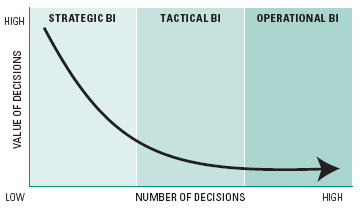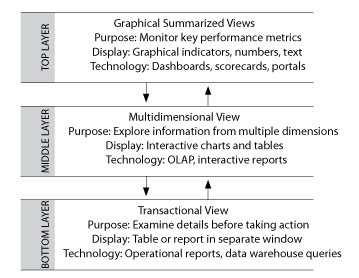Confusion in the meanings of BI and DW carries over to job titles.
| Welcome to TDWI FlashPoint. In this issue, Jennifer Hay explains the role of a good business analyst. CONTENTS
FlashPoint Snapshot FlashPoint Snapshots highlight key findings from TDWI's wide variety of research. Operational BI versus strategic and tactical BI 
Operational BI supports more lower-value decisions than strategic or tactical BI, but the collective impact of those decisions is significant.
Source: Best Practices in Operational BI: Converging Analytical and Operational Processes (TDWI Best Practices Report, Q3, 2007). Click here to access the report. Based on 423 respondents. Rounding and multiple-choice questions are responsible for percent totals that do not equal exactly 100 percent. Top
The Role of a Good Business Analyst Jennifer Hay, CBIP
The Problem Confusion in the meanings of business intelligence (BI) and data warehousing (DW) carries over to job titles. To create the perception of importance, BI or data warehousing is often included in a job title without regard to the actual job role. Nowhere is this more evident than the role of a business analyst. When we’re looking for a business intelligence analyst, or business analyst, we want someone who has the ability to help the business make informed decisions (the BI piece) and who also has the technical expertise to implement the solution (using some DW skills). Not only are we confused about the meanings, but when we use the terms interchangeably, we are also confused about the contribution that each makes. The ambiguity continues when we fail to distinguish between titles and roles. A title is used by an organization to identify a particular job, and is often associated with salary and authority. It may have little to do with the actual responsibilities. A role is defined by its responsibilities, the skills and knowledge needed to carry out the responsibilities, and the expected deliverables. A person with the title of business analyst may, in fact, be a business requirements analyst, a business process analyst, or a systems analyst. Giving a “business analyst” responsibility to design, develop, and deploy reports and OLAP cubes, and to administer and configure reporting tools, means that the job is technical and is not directly focused on business results. The role of a true business analyst starts with the definition of business intelligence. Consultant David Wells defines business intelligence as "the ability of an organization or business to reason, plan, predict, solve problems, think abstractly, comprehend, innovate, and learn in ways that increase organizational knowledge, inform decision processes, enable effective actions, and help to establish and achieve business goals." A good business analyst contributes to the ability of an organization to do all of these things. They provide opportunities to learn through business intelligence. Who are the analysts? Those who perform the role of a true business analyst often do so as part of larger roles and responsibilities. They don’t see themselves as analysts but as managers. Marketing managers analyze campaign effectiveness and customer behaviors. Financial controllers perform cash flow analysis, revenue analysis, and more. Compliance officers conduct risk analysis. Sales managers analyze pipelines and forecast sales volume and revenue. Customer support managers analyze customer satisfaction. R&D organizations perform competitor analysis and demand forecasting. HR analyzes employee retention, employee performance, regulatory compliance, and much more. Every good product or process manager does some kind of business analysis. None of these people has the title of business analyst as defined by the business, and they’re often not the power users as defined by IT. They go quietly about their business–commingling data as needed from operational and BI sources. Their objective is to resolve problems, identify conditions, and understand situations using the most direct and efficient means. The risk to the organization lies in not being able to identify or manage this valuable asset. What does it take to be a business analyst? Analysis is the process of breaking complex things into smaller, easier-to-understand pieces. It requires depth of knowledge about the subject being analyzed and the skill to break it into understandable pieces. It demands natural talent to understand each of the individual pieces, see the relationships between the pieces, and appreciate how each contributes to the whole. This combination of essential knowledge, the right skills, and natural talents is necessary. The three elements work together whether business analyst is your job or is part of a bigger job. Knowledge Knowledge is the understanding gained through education and experience. It is distinct from skills and talents, and is generally broader in scope. The business analyst needs knowledge of: - Business concepts and terms
- Business measurement principles
- Business metrics concepts
- Data analysis and design
- Business frameworks, such as customer relationship management (CRM), business performance management (BPM), and financial management
Skills Skills are concrete abilities that are needed to perform tasks and produce results. They are learned and can be applied to produce solutions in a problem domain. The skills needed by a business analyst include: - Business and data analysis
- Charting, graphing, and data visualization
- Statistical methods and statistical modeling
- Analytic technologies such as OLAP, business scorecards, performance dashboards, and data mining
- Monitoring and forecasting related to business processes and results
Talents Talents are the innate capabilities that a person brings to any endeavor. Although learning may enhance the ability to use talents, the talents themselves are inherent in personality, working style, and thinking style. Business analyst talents include: - Pattern recognition
- Understanding of cause and effect relationships
- Inquisitiveness and the desire to understand "why"
- Separation of complex subjects in to understandable pieces
- Analysis and understanding of complex processes, logic, and subjects
Knowledge and skills are essential for every business analyst. Analysts know how to use a variety of tools and techniques from spreadsheet macros and Excel PivotTables to data mining and pattern recognition. The distinguishing feature for analysts is not how they use their knowledge and skills, but how they apply their natural talents in combination with their other abilities. A good business analyst is naturally inquisitive, likes to take things apart to see what makes them tick, and is open to rethinking preconceived ideas. They are much like the annoying toddler who torments parents with a seemingly endless stream of "Why?" pleas. The desire to examine things and to dive into details makes them a natural choice for the role of business analyst. Consider, for example, a marketing manager in the role of unrecognized business analyst. Analyzing click-through responses with OLAP, she knows which channels have historically had the highest response rates. With some slicing and dicing, she sees more detail by product type, product, region, and date. Using this information, she plans marketing campaigns that mirror those with the best historical response patterns. On the surface, this seems like a logical way to make decisions and to plan marketing campaigns. OLAP works well to tell the manager what happened in the past and to help the manager make plans to repeat those successes. Using OLAP to look at the past is the most common analytical technique available to business analysts in a BI environment. Historical analysis drives decision-making within many organizations. It also drives organizations to make the same decisions over and over again. They lose opportunities for innovation and may be slow to respond when things change. The marketing manager, for example, won't discover new market opportunities through OLAP. The very same manager, however, supported with data mining and predictive analytics capabilities, might make different decisions –- to explore, innovate, and adapt to change. A business analyst equipped with the knowledge, skills, and talents to use data mining tools and techniques can see patterns in the data that suggest business opportunities. They understand what the patterns suggest, and know why the patterns exist and what they imply. Their knowledge and skills provide the know-how to use the tools and understand the data. Their talents provide the insight for looking into the future. Recognizing the hidden business analysts and supporting them with advanced analytic capabilities simply makes good business sense. Summary A business that does not recognize, reward, and nurture everyone who analyzes business data risks losing a valuable asset. An IT department that does not provide appropriate technical services to those who perform the role of a business analyst risks being misaligned with the needs of an organization in its quest for informed decision-making. Jennifer Hay, CBIP, is an independent consultant specializing in professional development and BI career guidance. She combines her knowledge of BI with an understanding of career dynamics to help individuals plan and shape their BI careers.
Top
FlashPoint Rx FlashPoint Rx prescribes a "Mistake to Avoid" for business intelligence and data warehousing professionals from TDWI's Ten Mistakes to Avoid series.
Ten Mistakes to Avoid When Creating Performance Dashboards
Mistake 4. Failing to Deliver Three Layers The problem with most dashboards and scorecards today is that they are “flat”—that is, they don’t contain the multiple layers of information that users often need to get to the root cause of a problem or issue. This layered approach gives users self-service access to information and conforms to the way most prefer to interact with information: (1) monitor, (2) analyze, and (3) examine. That is, most business users first want to monitor key metrics for exceptions; then explore and analyze information that sheds light on those exceptions; and finally, examine detailed data and reports before taking action. By starting at high-level views of information and working down, this layered approach helps users get to the root cause of issues quickly and intuitively. 
This excerpt was pulled from the Q1 2006, TDWI Ten Mistakes to Avoid series, Ten Mistakes to Avoid When Creating Performance Dashboards, by Wayne W. Eckerson.
Top
|